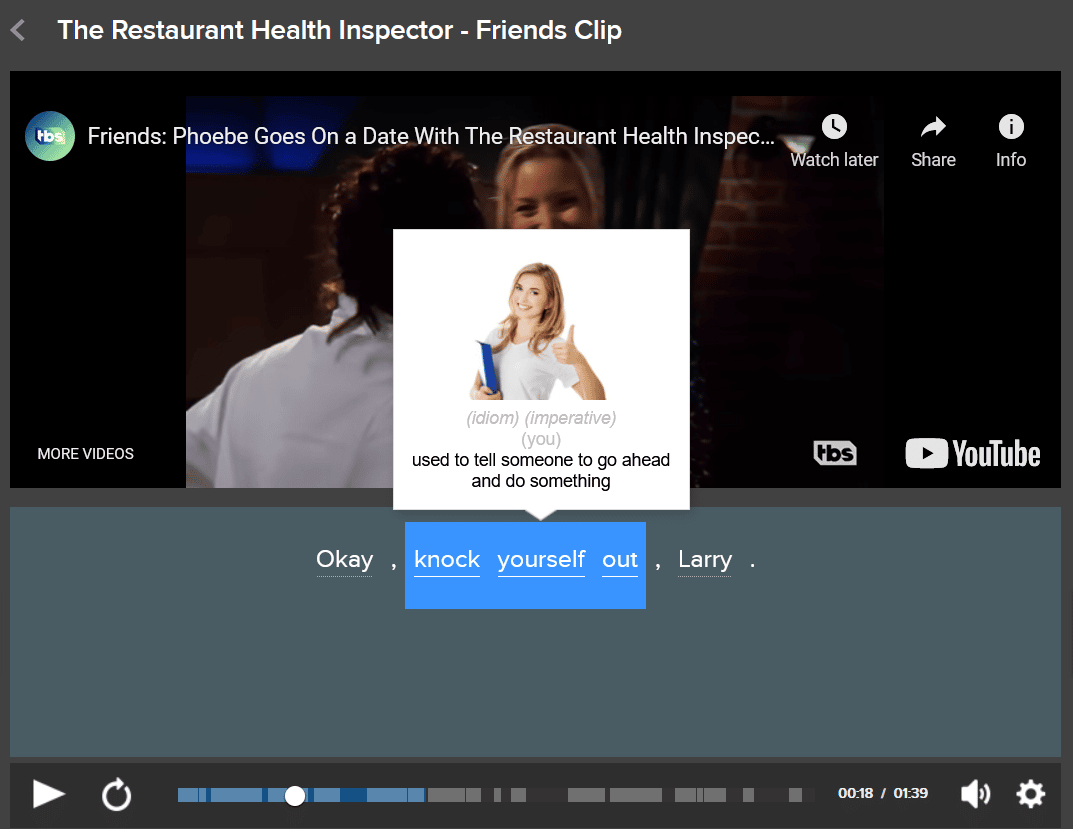How to Teach English Idioms Effectively

Idioms. They’re a lot of fun to teach and to learn, and they’ll make your students sound more like native speakers and become better listeners, more in tune to colloquial English.
In this guide, I’ll give you some tips for teaching English idioms to learners of any level, and give you some examples of key idioms that are worth teaching.
Download: This blog post is available as a convenient and portable PDF that you can take anywhere. Click here to get a copy. (Download)
How to Teach English Idioms for Each Level
Beginners
Some ESL teachers may find that teaching idioms is a waste of time with beginners. They can barely hold their own in a conversation, so why go teaching them confusing expressions that are tough to understand?
There are a few reasons why teaching English idioms to beginners is a good idea.
Firstly, it establishes common ground. All languages have idiomatic expressions, and by going over some in English, they’ll be encouraged to examine their own language usage and become more linguistically aware.
But perhaps more importantly, learning English idiomatic expressions is fun!
Beginners have the biggest hurdle to overcome when they first enter an ESL classroom: Learning to understand and to be understood.
And yet we spend a lot of time with beginners going over irregular verbs, memorizing vocabulary and learning basic phrases. Give them—and yourself—a break with a fun, creative lesson on English idiomatic expressions.
When you’re teaching English idioms to beginners, the most important thing to remember is to make it fun. Don’t sweat the small stuff.
1. Choose a theme
When you’re presenting idiomatic expressions to beginners, it’s a good idea to pick a theme.
Try choosing a list of 10 idioms in accordance with something like an upcoming holiday (on Halloween, try “green-eyed monster,” “going on a witch hunt”) or any theme that’s of interest to you and your class.
For example, if you’ve just done a lesson on food words, try making a list of food-related idioms (“You’re a peach!” “Easy as pie.”)
If you’re having a hard time coming up with idioms based on your theme, try this site which groups English idioms by theme for you, so you can pick and choose the ones you’d like to use.
2. Engage students in discovery
When introducing beginners to idioms, it can be fun to have them work in pairs or groups to try to discover what the idioms mean.
Of course, don’t get them started empty-handed! Create a matching worksheet with the definitions of the idioms on one side and the idioms themselves on the other.
Have students work together to decide which idiom means which thing. If necessary, you can use translation in the definitions.
The benefit of introducing idioms in this way is that it gets students thinking about how idioms work and maybe even making comparisons in their own languages.
3. Reinforce learning with a game
Once students have figured out which idiom has which meaning, it’s time for a game!
A really fun one to play with beginners is Charades. Since the person in front of the class doesn’t have to speak, it can be less scary for students to volunteer. Of course, the guessers will have to guess in English!
Place the idioms you’ve covered into a hat and have students come up one by one to act them out.
Be sure to think ahead if you plan to use this game—you wouldn’t want to pick idioms that are impossible to act out and risk frustrating your students.
Intermediate Learners
Intermediate learners may have a handle on some idioms, but not all. This is a great time to expand their idiomatic vocabulary with uses that are interesting to them.
With many students, this will mean involving pop culture like music. If you choose the song correctly, this can be a great opportunity to introduce more idiomatic expressions!
1. Pick an appropriate song
As the teacher, it’s important to do your homework before getting underway with any idiomatic expressions activity. You can’t just assume any song will have idiomatic expressions in it, as well you know!
Here are a few resources to help you find the right song to use with your class:
-
144 English Idioms | FluentU English BlogEnglish idioms are extremely common and understanding them is key to understanding the language as a whole. This post will introduce you to 144 of the most frequently used…
” target=”_blank” rel=”noopener”>Common Idioms in Songs
Of course, if you have another song in mind, go ahead and use that!
2. Warm up with a listening activity
Get students ready to listen closely by using a musical listening activity to get things rolling. Pick something that you know your class will catch onto fairly quickly so that you can get into the meat of the lesson.
3. Discuss the idioms found and introduce more
This is where you’re going to want to actually define the idiomatic expressions in the song.
The best way to do this is by reviewing what an idiomatic expression is with your class and then asking students to identify the expressions themselves.
This sort of guided discovery can help students understand the idioms in the song and find their own definitions, which you can verify with them and correct if needed.
Once your students have uncovered all the idioms in the song, you can take the opportunity to talk about musically-themed idiomatic expressions with your class and encourage them to try to use them.
You can add more idioms to the list from some of the resources listed in the beginners’ lesson above.
Give students a list of around 10 or 20 to work with, which you can test either by assigning a writing activity, giving a quiz a few days later or playing some games, like Charades or even a version of Taboo.
In this game, students are allowed to describe the meaning of the idiom, but they can’t use any of the words in the expression. Other students must guess the idiom that’s being described.
Another option is to use a video activity. We love the Head Over Heels activity, which is a lot of fun to use if you’re going to be studying idioms for several classes.
Advanced Learners
By the time you’ve got a classroom full of advanced learners, idiomatic expressions have likely already been covered. Many idioms have already been acquired, and yet there’s still a ways to go.
1. Identify a list of English idioms
First, you’ll need to find some idioms that your advanced learners may not have seen before.
These 66 idioms are common in spoken English, but they likely haven’t been addressed yet in other classes.
They’re a bit rarer than some of the others that may have come up in previous classes, and they’re quite varied, meaning that even if some have come up in thematic lessons, others will not have been covered.
In other words, you’ll have a fairly good balance between familiar and novel.
Have students scan the list and discuss the idioms they already recognize.
2. Guide students through an idiomatic research project
Either alone or in pairs, ask students to carry out a research project (in English, of course!) on a given idiomatic expression.
Dole out the expressions and let each student know that they’ll need to give a 5-10 minute presentation to the class on the expression.
This research project can take several different directions.
It can be interesting to ask advanced learners to find an equivalent of idiomatic expressions in their native tongue and discuss the differences in English.
At an advanced level, it’s not necessarily problematic to introduce a few words of the native tongue as a point of comparison.
Of course, if you’d prefer not to introduce other languages into your ESL classroom, you can still ask students to research the etymology of certain idiomatic expressions.
Guide them towards more extensive dictionaries like the Concise Oxford Dictionary of English Etymology, if your students have library access, or the Online Etymology Dictionary if they don’t.
Make sure you ask for works cited, especially to keep students from wandering over to Wikipedia for the bulk of their research!
3. Back up your students with extra material
Take advantage of each student’s presentation of his or her expression, effectively teaching it to the class, to launch in-class discussions of expressions and idioms.
Allow for two presentations per class day, splitting them up with a discussion or conversation lasting about 20 minutes.
This is the ideal moment to introduce additional information that you’ll have uncovered about the expression, including historical information, that you can find online.
Tips for Teaching English Idioms Effectively
Whatever level you’re teaching, you can apply these tips to help your students understand idioms better:
Combine idioms with pictures
Provide a picture along with the idiom. This works best if you show an image that humorously illustrates the literal meaning of the idiom. It will make students laugh, but also help them understand or guess what a phrase means.
Idioms are full of colorful imagery, perfect for a flashcard or photo. Show the picture to your students and have them guess the meaning of the idiom.
From there, give examples of when you would use it and how the words and the actual meaning of the idiom are different.
Looking for a good resource? Check out this website for an example of great images to explain the meaning of idioms.
And for some beautiful images depicting idioms, be sure to check out this site.
Provide idioms in context
This way, students can fully understand the meaning. Be sure to provide a sample conversation around it. For example, take the following dialogue featuring the idiom “to be a chicken” when at a local amusement park.
Jack: Ooh, wow. Look at that roller coaster, Jane! It goes upside-down!
Jane: My stomach aches just looking at it. I will not ride that.
Jack: Ah, come on. Don’t be a chicken!
Watching videos of native speakers conversing is a great way to show your students how idioms are used in the real world.
FluentU is one resource that can help you highlight the usage and context of the various idioms used by your students.
FluentU has hundreds of native English videos like inspirational talks, funny commercials and movie quotes. Search for a phrase or an idiom and you might even find it being used in one of the many videos.
If not, FluentU lets you create flashcard decks so you can dedicate certain decks to common idioms.
Students can also watch videos and spot sayings that they like. With the support of contextual definitions from within the subtitles, students will have no trouble understanding the meaning of each word and phrase.
Your students can use FluentU on their iOS or Android devices, as well as in browsers.
Teach idioms in spoken form, not written
Explain to students how they are conversational, rather than formal. Have students practice the idioms in dialogue to help them understand they’re used in spoken colloquial English.
To make it more interactive, you can even break your class into small groups and ask each group to look up two idioms. Dave’s ESL Cafe has a great collection of idioms and their meanings for student reference.
Before they look them up, have the students make an educated guess on what the idiom means, and then let them search for the real meaning.
Have students explain the meaning to the rest of the class and use the idiom in a short sample dialogue.
Explain each idiom thoroughly
Don’t just hand out a long list of idioms. Be sure to provide a small selection of 5-10 idioms (or less!) and explain each one.
If you provide too many examples, it’ll simply turn into an introduction of what an idiom is, rather than how to actually remember the meaning and use one effectively in dialogue.
Be sure to explain too how the individual words have different meanings from the whole idiom phrase. For example, how much does an arm and a leg actually cost? Who knows?
Introduce Amelia Bedelia
No, Amelia! You don’t actually throw the tent into the woods!
You don’t have to be a kid to adore Amelia Bedelia and her literal mind. She’s the perfect teacher for an idiom lesson.
Visit the official website for activities, book excerpts, worksheets and games. While the material is oriented for children, it’s also a great way for older students to learn English idioms through a fun and quirky character!
10 English Idioms Worth Teaching
As you can see, there are hundreds of great resources for teaching idioms. Where should you even start? Remember, it’s important to provide context around your idioms.
So to get you started, we’ve listed a few of our favorites with a sample dialogue and some additional teaching tips.
1. A fish out of water
Meaning: to feel awkward or uncomfortable, usually in a new situation
Teaching tips: Start the lesson by talking to your students about feeling awkward. What makes them feel awkward? Give an example of what makes you feel awkward. Then, present the below dialogue.
Sample dialogue:
Sam: Gee, learning to rollerblade isn’t easy. I keep falling down!
Sarah: I know, it’s so hard! I feel like a fish out of water.
2. To be broke
Meaning: to be out of money, to have no money
Teaching tips: Provide the students with two images. One image should be of a broken item (such as a broken pencil) and one should be an image of a person with no money (this is a great one).
Explain how both images mean “to be broke.” Then, present the following dialogue and have the students match the correct image to the meaning of the idiom.
Sample dialogue:
Sam: I really want to buy that cool hat. But I’m completely broke.
Sarah: Would you like to borrow some money?
Sam: That’d be great. I promise, I’ll pay you back later.
3. Rule of thumb
Meaning: an unwritten but generally accepted guideline, policy or method of doing something
Teaching tips: Talk with your students about laws of society. Which ones are actual legal laws? Which ones are social norms or generally accepted rules?
Make a list of each. Then, introduce the “rule of thumb” idiom. Practice with the below dialogue.
Sample dialogue:
Sam: These potato chips are so delicious. Want some?
Sarah: Sure, thanks.
Sam: Ooh, sorry! I dropped that handful. Well, it’s the 5-second rule. They were on the ground less than 5 seconds, so it’s still okay to eat them.
Sarah: What? Yuck. That doesn’t sound like a good rule of thumb. Give me some that haven’t dropped on the ground, please!
4. Up in the air
Meaning: undecided or indefinite, usually because often because other matters should be decided first
Teaching tips: Present this image, featuring the idiom “up in the air.” Talk to the students about what it means, and then present the following dialogue.
Afterward, talk about what your students are currently up in the air about. Then, have them come up with their own sample dialogue.
Sample dialogue:
Sarah: Hey, Sam! Remember, you need to let us know by tomorrow if you’re going to go on the class trip with us.
Sam: That’s right. I’m still up in the air. I need to figure out my work schedule first and see if they’ll let me have a few days off work.
Sarah: I see. Well, let us know. I hope you can come!
5. Devil’s advocate
Meaning: to present a counter argument
Teaching tips: After explaining the meaning of this idiom and practicing the following dialogue, present the class with a debate exercise.
Split the class into two groups, and have each side come up with a different argument for the same issue. (Choose an issue you think might be relevant to your students).
Have them debate the issue, using the idiom when appropriate.
Sample dialogue:
Sam: I just can’t understand why healthcare is so expensive in the United States. It just doesn’t seem right.
Sarah: Tell me about it. But, to be the devil’s advocate, doctors get paid more in the US than in any other country. And so that attracts the best doctors in the world who possibly provide some of the best care in the world.
Sam: Well, maybe. But it still shouldn’t be so expensive.
6. Give someone the cold shoulder
Meaning: to no interest in someone or something, to ignore
Teaching tips: Have the students guess what they think the idiom means. Ask the students if they’ve ever given someone the cold shoulder. Or, if they’ve ever received the cold shoulder. Practice with the dialogue below.
Sample dialogue:
Sarah: I ran into Sallie yesterday and we had a nice conversation at the coffee shop, catching up with each other.
Sam: Oh, really? Last time I saw her, she gave me the cold shoulder. I couldn’t figure out what I had done to make her angry.
Sarah: Well, it probably doesn’t help that you are dating her best friend.
7. Happy camper
Meaning: a person who is happy and cheerful
Teaching tips: Explain the idiom and practice the sample dialogue. Ask your students what makes them happy. Also, practice using the idiom in the negative. Such as, “I’m not a happy camper today.”
Sample dialogue:
Sam: Sarah, why are you so happy today?
Sarah: Well, I made a perfect score on my English test. I also won first prize in an English writing contest and received a $100 prize. So yes, I’m a happy camper today.
Sam: Wow, congratulations!
8. Sit tight
Meaning: to stay where you are
Teaching tips: Explain the definition of the idiom and practice the dialogue below. Have the students come up with scenarios where they could use this idiom in context.
Sample dialogue:
Sarah: Sam, are you okay? What happened?!
Sam: I fell down the stairs, and now my leg really hurts.
Sarah: Sit tight! I’ll go call 9-1-1.
9. Head over heels (in love)
Meaning: to be really or completely in love with someone
Teaching tips: Show this image explaining the idiom. Talk to the students about being in love. Ask which students are currently in love (guaranteed to elicit a few giggles from your students!). Practice the below dialogue.
Sample dialogue:
Sarah: Sam, what are you writing?
Sam: I’m writing a letter to my new girlfriend.
Sarah: Ooh, really? You just wrote to her yesterday. You must be head over heels!
Sam: I really am. I want to marry her.
10. Get the ball rolling
Meaning: to get started
Teaching tips: Write the idiom on the board in front of the class. Have the students make guesses on what it means. Then, practice the below dialogue and have them guess again.
Sample dialogue:
Sam: Have you started the English class project yet?
Sarah: No, not yet. I need to ask the teacher a few more questions first.
Sam: You better get the ball rolling! The project is due next week!
Sarah: Don’t worry about me. I’ll get it done.
Now, get your idiom ball rolling. And don’t beat around the bush!
Download: This blog post is available as a convenient and portable PDF that you can take anywhere. Click here to get a copy. (Download)
















